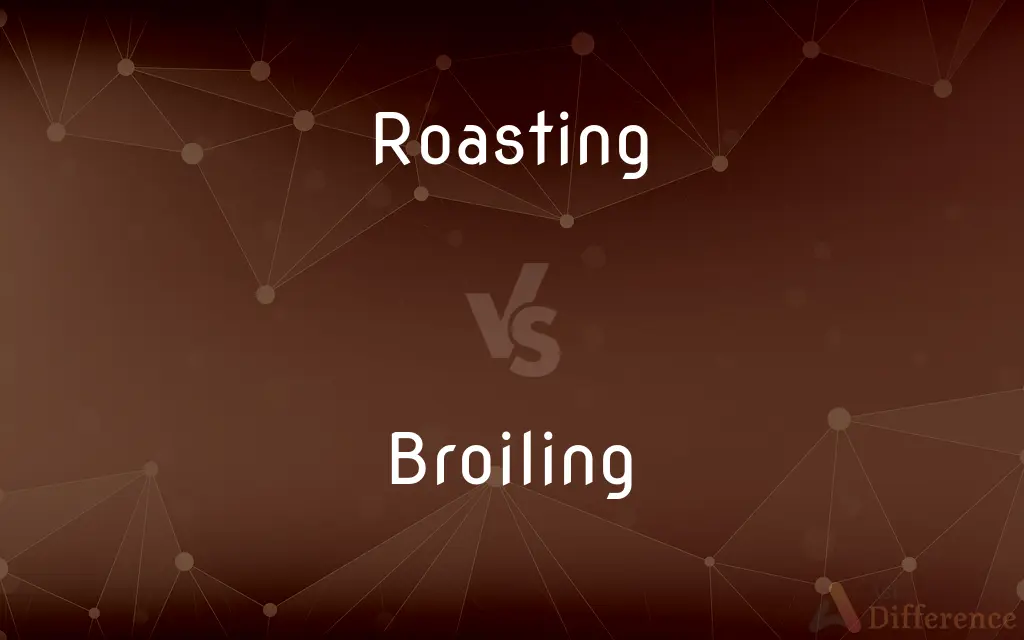Roasting vs. Broiling — What's the Difference?
Edited by Tayyaba Rehman — By Fiza Rafique — Updated on April 18, 2024
Roasting involves cooking food using indirect heat in an oven, creating a uniform exterior, while broiling uses direct overhead heat for a quicker, charred finish.

Difference Between Roasting and Broiling
Table of Contents
ADVERTISEMENT
Key Differences
Roasting is a cooking method that utilizes indirect heat in an oven to cook food evenly, usually at temperatures from 200°F to 400°F. Whereas broiling employs direct, high-intensity radiant heat from above, typically at temperatures above 500°F.
When roasting, heat circulates around the food, allowing it to cook slowly and evenly, perfect for larger or denser items like whole chickens or roasts. On the other hand, broiling is ideal for quickly cooking thinner cuts of meat or vegetables, as it provides a charred, crispy surface.
Roasting often involves basting the food with its juices or added fat to enhance flavor and prevent drying out, enhancing its tenderness and moisture content. Conversely, broiling typically does not involve basting; the high heat quickly sears the surface, locking in flavors.
The equipment needed for roasting includes a roasting pan or a baking dish, which helps in collecting juices and fats. In contrast, broiling requires a broiler pan that allows excess fats to drip away, promoting a healthier outcome.
Roasting is suitable for cooking at a leisurely pace, making it a favorable choice for holiday meals or gatherings. Broiling, being much faster, suits everyday cooking when time is limited.
ADVERTISEMENT
Comparison Chart
Heat Type
Indirect, from all sides of the oven
Direct, from an overhead element
Typical Temperature
200°F to 400°F
Above 500°F
Cooking Time
Longer, suitable for large or dense items
Short, ideal for quick cooking of thin cuts
Equipment Needed
Roasting pan or baking dish
Broiler pan
Common Uses
Whole poultry, large roasts, dense vegetables
Steaks, fish fillets, sliced vegetables
Compare with Definitions
Roasting
A method that allows for basting and slow cooking.
She prefers roasting her vegetables to caramelize them evenly.
Broiling
Cooking food using direct overhead heat.
Broiling salmon fillets quickly gives them a delicious crust.
Roasting
Suitable for large, dense foods.
Roasting a beef brisket slowly breaks down the connective tissues.
Broiling
Does not usually involve basting.
Broiling is ideal for a no-fuss, quick meal.
Roasting
Typically utilizes a roasting pan.
Using a roasting pan helps collect the juices for making gravy.
Broiling
Intense heat for quick surface searing.
Broiling steaks results in a flavorful charred exterior.
Roasting
Cooking food using indirect heat in an oven.
Roasting a whole turkey for Thanksgiving dinner enhances its flavor and tenderness.
Broiling
Often used for thinner cuts or smaller items.
Broiling asparagus brings out a smoky flavor.
Roasting
Enhances moisture retention and flavor.
Roasting chicken at lower temperatures keeps it moist.
Broiling
Uses a broiler pan to allow fats to drip.
The broiler pan lets excess fat drip away from the meat while cooking.
Roasting
Roasting is a cooking method that uses dry heat where hot air covers the food, cooking it evenly on all sides with temperatures of at least 150 °C (300 °F) from an open flame, oven, or other heat source. Roasting can enhance the flavor through caramelization and Maillard browning on the surface of the food.
Broiling
To cook by direct radiant heat, as over a grill or under an electric element.
Roasting
To cook with dry heat, as in an oven or near hot coals.
Broiling
To expose to great heat.
Roasting
To dry, brown, or parch by exposing to heat.
Broiling
To be exposed to great heat.
Roasting
To expose to great or excessive heat.
Broiling
To engage in a rowdy argument.
Roasting
(Metallurgy) To heat (ores) in a furnace in order to dehydrate, purify, or oxidize before smelting.
Broiling
The act of broiling or the condition of being broiled.
Roasting
To ridicule or criticize harshly.
Broiling
Food, especially meat, that is broiled.
Roasting
To honor at or subject to a roast.
Broiling
A rowdy argument.
Roasting
To cook food in an oven.
Broiling
Very hot.
Roasting
To undergo roasting.
Broiling
A food prepared by broiling.
Roasting
Something roasted.
Broiling
Gerund of broil: the act of broiling.
Roasting
A cut of meat suitable or prepared for roasting.
Broiling
Present participle of broil
Roasting
The act or process of roasting.
Broiling
Excessively hot; as, a broiling sun.
Roasting
The state of being roasted.
Broiling
Cooking by direct exposure to radiant heat (as over a fire or under a grill)
Roasting
Harsh ridicule or criticism.
Roasting
A facetious tribute, as at a banquet, in which the honoree is alternately praised and insulted.
Roasting
Roasted
Roast duck.
Roasting
Present participle of roast
Roasting
(colloquial) Very hot.
The day started out cool, but by noon it was roasting.
Roasting
The act by which something is roasted.
Roasting
(colloquial) A rebuke or reprimand (usually from the recipient's point of view).
My boss gave me a roasting for last month's sales figures.
Roasting
Cooking (meat) by dry heat in an oven (usually with fat added);
The slow roasting took several hours
Common Curiosities
What is the primary difference between roasting and broiling?
The primary difference lies in the heat source; roasting uses indirect heat, while broiling uses direct overhead heat.
What type of pan is best for broiling?
A slotted broiler pan is best as it allows fats to drip away from the food.
Is roasting suitable for vegetables?
Yes, roasting is excellent for vegetables as it caramelizes their natural sugars and enhances flavor.
Can you broil large roasts?
Broiling is not recommended for large roasts as the intense, direct heat may burn the exterior before the inside is properly cooked.
Can broiling be considered a healthy cooking method?
Yes, broiling can be healthier as it allows fat to drip away from the food, reducing caloric intake.
Can you use aluminum foil in broiling?
Yes, you can use aluminum foil in broiling to help with cleanup or to catch drips, but be careful as it can reflect heat and affect cooking times.
What types of foods are best avoided when broiling?
Foods that are very thick or dense, such as large roasts or whole chickens, should be avoided as they may not cook evenly under the broiler's intense heat.
What is the effect of marinating on roasting and broiling?
Marinating can enhance the flavor and tenderness of foods for both roasting and broiling. For broiling, it also helps in creating a caramelized crust due to the sugars in the marinade.
How do you prevent food from drying out when roasting?
To prevent drying, you can baste the food periodically with its own juices or added fats, and using a lower temperature can also help maintain moisture.
Is there a nutritional difference between roasting and broiling?
The nutritional differences can vary based on the cooking method and the use of added fats. Broiling may result in lower fat content since excess fat drips away, whereas roasting, especially if basting is involved, might retain more fat and calories.
Share Your Discovery

Previous Comparison
Brochure vs. Pamphlet
Next Comparison
Outbox vs. SentAuthor Spotlight
Written by
Fiza RafiqueFiza Rafique is a skilled content writer at AskDifference.com, where she meticulously refines and enhances written pieces. Drawing from her vast editorial expertise, Fiza ensures clarity, accuracy, and precision in every article. Passionate about language, she continually seeks to elevate the quality of content for readers worldwide.
Edited by
Tayyaba RehmanTayyaba Rehman is a distinguished writer, currently serving as a primary contributor to askdifference.com. As a researcher in semantics and etymology, Tayyaba's passion for the complexity of languages and their distinctions has found a perfect home on the platform. Tayyaba delves into the intricacies of language, distinguishing between commonly confused words and phrases, thereby providing clarity for readers worldwide.














































